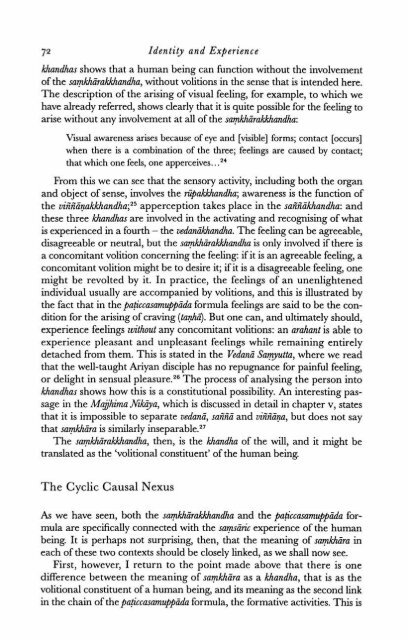Identity and Experience_Hamilton_1996
Identity and Experience_Hamilton_1996
Identity and Experience_Hamilton_1996
Create successful ePaper yourself
Turn your PDF publications into a flip-book with our unique Google optimized e-Paper software.
72 <strong>Identity</strong> <strong>and</strong> <strong>Experience</strong><br />
Wt<strong>and</strong>has shows that a human being can function without the involvement<br />
of the samkhirakkh<strong>and</strong>ha, without volitions in the sense that is intended here.<br />
The description of the arising of visual feeling, for example, to which we<br />
have already referred, shows clearly that it is quite possible for the feeling to<br />
arise without any involvement at all of the sapkhiirakkh<strong>and</strong>ha:<br />
Visual awareness arises because of eye <strong>and</strong> [visible] forms; contact [occurs]<br />
when there is a combination of the three; feelings are caused by contact;<br />
that which one feels, one apperceives.. .24<br />
From this we can see that the sensory activity, including both the organ<br />
<strong>and</strong> object of sense, involves the rzipakWurndha; awareness is the function of<br />
the vififiiinakkh<strong>and</strong>h~;~~ apperception takes place in the saiifiikh<strong>and</strong>ha: <strong>and</strong><br />
these three kh<strong>and</strong>has are involved in the activating <strong>and</strong> recognising of what<br />
is experienced in a fourth - the vedizniikh<strong>and</strong>ha. The feeling can be agreeable,<br />
disagreeable or neutral, but the samkhiirakkh<strong>and</strong>ha is only involved if there is<br />
a concomitant volition concerning the feeling: if it is an agreeable feeling, a<br />
concomitant volition might be to desire it; if it is a disagreeable feeling, one<br />
might be revolted by it. In practice, the feelings of an unenlightened<br />
individual usually are accompanied by volitions, <strong>and</strong> this is illustrated by<br />
the fact that in the paticcasamuppiida formula feelings are said to be the condition<br />
for the arising of craving (tayhi). But one can, <strong>and</strong> ultimately should,<br />
experience feelings without any concomitant volitions: an arahant is able to<br />
experience pleasant <strong>and</strong> unpleasant feelings while remaining entirely<br />
detached from them. This is stated in the Vedanii Samyutta, where we read<br />
that the well-taught Ariyan disciple has no repugnance for painful feeling,<br />
or delight in sensual pleasure.26 The process of analysing the person into<br />
kh<strong>and</strong>has shows how this is a constitutional possibility. An interesting passage<br />
in the Majjhima Nhya, which is discussed in detail in chapter v, states<br />
that it is impossible to separate vedani, saiifii <strong>and</strong> uifi'iiiina, but does not say<br />
that sa*iira is similarly in~eparable.~~<br />
The samkhiirakkh<strong>and</strong>ha, then, is the kh<strong>and</strong>ha of the will, <strong>and</strong> it might be<br />
translated as the 'volitional constituent' of the human being.<br />
The Cyclic Causal Nexus<br />
As we have seen, both the samkhiirakkh<strong>and</strong>ha <strong>and</strong> the paticcmamuppiida formula<br />
are specifically connected with the sa~ii?ic experience of the human<br />
being. It is perhaps not surprising, then, that the meaning of samkhiira in<br />
each of these two contexts should be closely linked, as we shall now see.<br />
First, however, I return to the point made above that there is one<br />
difference between the meaning of samkhiira as a kh<strong>and</strong>ha, that is as the<br />
volitional constituent of a human being, <strong>and</strong> its meaning as the second link<br />
in the chain of the pagccasamuppida formula, the formative activities. This is


